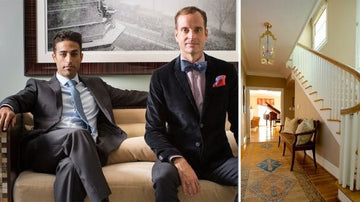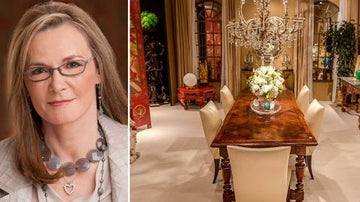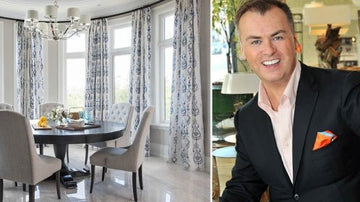Robert Allen Designer Spotlight – FORM
FORM is the collaboration of Emmy award winning designer Joshua Rose and Chinese medical practitioner Rafael Kalichstein. Joshua’s years in visual effects and production design for film and television offer a unique and unparalleled perspective in the field of design. Rafael has had a nearly twenty-year journey in the world of Eastern healing and later became a certified practitioner of Black Hat Feng Shui, which practice he integrates into his design work. Joshua and Rafael believe that spaces speak. In order for a design to succeed, it is imperative that the designer listen. FORM strives to be an arbiter of taste and holistic living, blending the line between what is beautiful and what sustains. We hope to evolve the principle that “form follows function” such that neither should suffer the role of leader nor follower; rather, the relationship becomes harmonious, cyclical and seamless.
1. How did you both meet and what inspired you start an Interior Design firm?
We met on a blind date, set up by a Vedic astrologer. He swears it was not an astrological set up, but rather, we were two good people who “should know one another.” The rest is, as they say, history. The origins of our firm are rather magical. We bought the worst house on a great street in the Franklin Hills in 2006. Although neither of us were strangers to design and renovation, it was the first project of its scope we had tackled and we had no formal design training. In the end, our varied backgrounds in the film industry and Eastern healing paid off, and the renovation was a huge success. So much so that our good friend, a major broker in the Silverlake / Los Feliz real estate world at the time, thought we should consider a design business and quickly brought us our first client.
2. How do you collaborate as partners to accomplish your design vision?
We collaborate as partners by, first, finding a core design inspiration. It can be as specific as a location—Rome, Brussels, Miami—or as abstract as a feeling—whimsy, elegance, earthiness. Often, it is a set of words—three, in fact—that are worked down from a master list of wild dreams we envision for the project. From there we diverge slightly, sometimes going in two completely different directions from the same core inspiration. We then rework these ideas, using the same methodology we use with the words, in the end, we weave the most honest and honed of these ideas into a uniform design that would never have existed, were it not for our collaboration and this process. Dreams become words become ideas become plans become reality: design.
3. What sources of inspiration do you look for when you start a new project?
When we begin a project, our first spring of inspiration flows from that about which we are most excited at that moment, whether it be a recent trip, art exhibit, musical piece, or book we are reading. We find design in all parts of our lives and are excited to create uniquely inspired spaces for our clients that stem from that understanding.
4. What is your favorite travel destination?
Italy is an endless source of beauty, inspiration, knowledge and gluttony we never tire of. Isla Holbox, in Mexico, is the ultimate battery drain, decompress, and recharge.
5. Describe your design aesthetic in 10 words or less.
Timeless, chic, and livable.
6. What attracts you to different colors/textures in fabrics?
We very frequently have a strong emotional response to fabrics, sometimes “ooh-ing” and “aah-ing” with total abandon in the middle of a showroom and sometimes . . . not. We are always drawn to the way a fabric plays with light and, most importantly, its hand. No matter how beautiful a fabric is, if the hand is bad, you won’t find it for use on upholstery in any of our projects… well, maybe a throw pillow if it’s fabulous, but we draw the line there.
7. What is your favorite (go-to) textile from Robert Allen or Beacon Hill? How have you used it in your projects?
Of late, our favorite “go-to” textile form Beacon Hill is the Mohair Bouclé. It is such a delicious and luxurious take on bouclé; refined and organic, glamorous and comfortable. We have used it for upholstery and throw pillows and are now scheming for a heavy set of drapes on a new project. Our favorite colors are the ivory, warm gray, and linen.
8. What is your favorite project that you have done with Robert Allen / Beacon Hill and why? Can you provide examples of this project?
A favorite project we did with Robert Allen / Beacon Hill fabrics is a traditional home in Hancock Park, California. The clients are very well traveled, hold a great position in the community, and are alternatingly adventurous and conservative in their decision-making. It was also the second project we had done for them, so there was a level of freedom and range of inspiration that allowed us to use a wide variety of fabrics from traditional and ethnic to organic and decadently contemporary.
9. You are based in Los Angeles, how does the California lifestyle of indoor outdoor living influence your fabric selections for projects?
For us, context is everything. The location and use are paramount to our specification. While the word “patina,” may be overused—in fact, it is: “Patina” is the new “curate”—we seek to create spaces that patina gracefully with time. We don’t want the most beautiful day for the room to be the day it installs, we want a deeper beauty to come to the space over time, through love and use, so we specify fabrics that can live in that world.
10. What fabric trends do you predict will become important in the next 2 years?
We think a return to unrestrained elegance and beauty is coming; flawless neutrals in the most indulgent of materials and a visible hand in the embellishments are coming back. We recently tried to find a heavenly plush mohair in white and weren’t able to do so. Watch. It will be all the rage in 2017.









